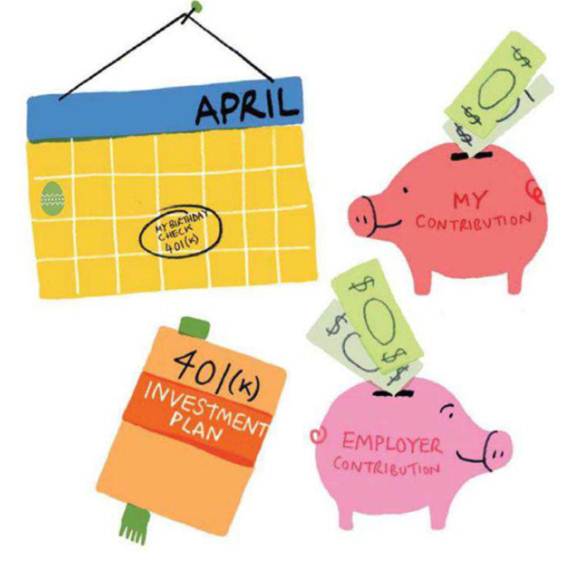The
easiest investment will become easier with our step by step instructions

Money investment can be messy. But if
your company offers 401(k) retirement packages, you obviously should take it.
“The money you save today will be the way to sustain when you retired”, Beth
Kobliner, author of Get a Financial Life and member of the Financial
Capacity Advisory Committee of the president, said. Not hard to start, and
every $1 you invest in 40 years old could be double at the time you are 65
years old. (Invest $1 when you were 30 years old and it could be $5 at your
retirement, invest $1 at the age of 20, that may be worth $10!). Here's how to
use the 401(k) package.
Evaluate your risk level. Before investing
anything, you need to determine how much risk you want to take with your money.
Are you willing to take more risk to be paid more or want to be “slow but sure”
with your speed? Kobliner proposals, come to the investor questionnaire of
Vanguard (personal.vanguard.com /us/FundsInvQuestionnaire) or see your 401(k)
management company if they provides a risk survey. “The results will reveal
your comfort level with investment in stocks (riskier) compare with bonds (more
conservative). Closer to retirement, the more careful you should be, because
you will need money sooner. The risk surveyswill consider that when proposal a
suitable package for you”.
Consider fund. Many 401(k) packages
provide target date funds. They are a mixture of packaged investment based on
your expected retirement day, is designed to automatically adjust the
investment (and risk) when time passes. You just need to give your retirement
plan, and respective fund will be selected. Done!
If you do not like this fund, let’s go
to the Financial Engines (financialengines.com), which can help you to find the
best investment mix by using information you provide (age, expected retirement
date, saving rate, etc.). A registration with website cost 39.95 USD/3 months,
but before you sign up, talk to the personnel management of your company,
because many employers provide free access to Financial Engines.
Find the discount. If your company offers a
discount for 401(k), they guarantee that they will give you a specific % rate
in your contribution, such as 50 cents for every dollar you invest. It's free
money, Kobliner said. (Companies ussualy minus about 1 to 6% of your salary).
So suppose your annual salary is 50 thousand dollars and you contribute 6%
($3000) for 401(k) package. If the discount rate of your company is 50%, it
means they will give you $1500. Although some companies stop discount a few
years ago due to economic crisis, 74% recovered it, according to a recent study
by Towers Watson, human resources consulting firm, revealed.
Depending on the number. Things to do first: find
out how much money you will need for retirement - basically, what you need to
maintain the current standard living when you stop working. A great place to
find that number?
Moneychimp
(moneychimp.com/features/401k_calculator.htm). When you know your final goal,
consider whether you want to increase the regular contributions amount or not,
according to Scott Holsopple, CEO of Smart401K.com, website is specialized
401(k) knowledge, explained. “Some packages allow you to set the automatic
increase based on the date you choose”. If that is not selected in your plan,
set up reminders in the calendar to increase your contribution each year on the
anniversary, birthday or when you get a raise.
Know the cost. 401(k) is not free. Your
401(k) management company charges for the services they provide - usually from
1% to 1.5% of your settlement sheet annually, Holsopple said. These other funds
have higher fees and the more services you use (Ex: special products such as
target date fund), the more you have to pay.
There is one problem: until now, it's
hard to know how much you are paying because cost is rarely showed on the
notice. “But thanks to a federal regulation, which will begin at the end of
this year, the plan provider have to give 401(k) saver more detailed
information about fees and expenses attached with their package”, Kobliner
explained.
Keeping costs at minimum by asking
account manager about how much you are paying for the specific funds and
whether you should change or not. Fund cost can range from less than 1% to 2%
or more. 1% difference sounds not much, but with time, it can take away a big
part of your money.
An analysis of Labor Department found
that adding 1% for an investment in 35 years can reduce the total amount you
receive at retirement to 28%. In other words, an account of $50,000 may become
only 36.000 dollars!
Remittance with you. If you quit your job,
technically you are allowed to leave 401(k) package on your using account, as
long as you have at least $5000 in account. “But I recommend you take old
401(k) account into the new one with your new company (if you're still working)
so you can continue to pay the fee and take advantage of the discount in new
company”, Kobliner explained.
Do not withdraw cash soon. Need a little amount of
money to pay the mortgage in a month with financial problem, or your child's
college tuition? “My mantra: stay away from your 401(k)!” Kobliner said. If you
withdraw from 401(k) before the age of 59,5 - for whatever reason - you may pay
a penalty of 10% plus tax. So 10 thousand dollars will be about $6000 or $7000.
At this point, you can borrow money from bank with much better terms.
How much is your money?
Start saving $10.000/year in 401(k)
and depending on the age you start saving, you will have this amount of money
after tax.
|
Start at
|
Retire at 65 with
|
|
25
|
$1,268,397
|
|
35
|
$697,607
|
|
45
|
$347,192
|
|
50
|
$132,067 |